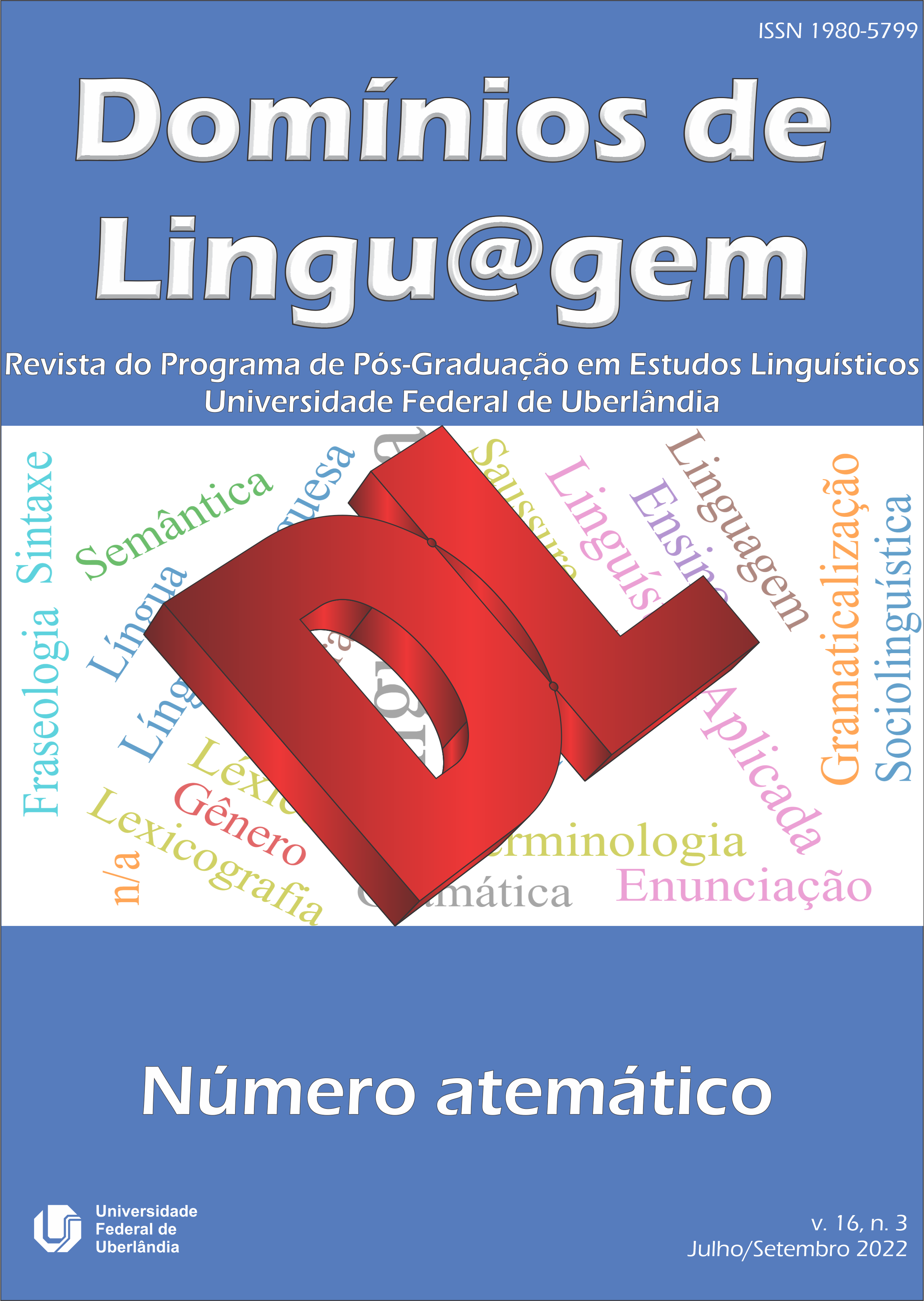Effects of the decrease in the frequency of the third formant in the approximant pronunciation of coda /r/ on the social perception of speakers in São Bernardo do Campo
DOI:
https://doi.org/10.14393/DL51-v16n3a2022-2Keywords:
Coda /r/, Retroflex /r/, Sociolinguistic perception, Matched-guise, Third formantAbstract
This study reports evidences that gradual differences in the frequency of the third formant in the pronunciation of coda /r/ can provoke equally gradual differences in how speakers are socially evaluated in São Bernardo do Campo, a city in Greater São Paulo. A sociolinguistic perception experiment designed according to the matched-guise technique (LAMBERT et al., 1960) was conducted with 58 residents of the city, which were asked to listen to a recording of the speech of a person reading a sentence, and then to fill out a questionnaire about the speaker. The auditory stimuli differed only in the tokens of coda /r/, each of them presenting only one of three levels of decrease in the third formant. The results indicate correlation between the decrease and the way in which the speakers were evaluated. The decrease in the frequency of the third formant correlated with the increase in the rate of the responses that evaluated the speakers as having more accent and as being resident of São Bernardo do Campo. This result suggests that social meanings of linguistic forms can vary gradually when indexed by gradual phonetic variables.
Downloads
Metrics
References
AMARAL, A. O dialeto caipira. São Paulo: Parábola, 2020.
ATAL, B. S.; HANAUER, S. L. Speech analysis and synthesis by linear prediction of the speech wave. The Journal of the Acoustical Society of America, v. 50, n. 2B, p. 637–655, 1971. DOI: https://doi.org/10.1121/1.1912679
BOERSMA, P.; WEENINK, D. Praat: doing phonetics by computer [Computer program]. Disponível em: http://www.praat.org/.
BRANDÃO, S. F. Nas trilhas do -r retroflexo. SIGNUM: Estud. Ling, 2007. DOI: https://doi.org/10.5433/2237-4876.2007v10n2p265
CAMPBELL-KIBLER, K. The nature of sociolinguistic perception. Language Variation and Change, v. 21, n. 1, p. 135–156, 2009. DOI: https://doi.org/10.1017/S0954394509000052
DELATTRE, P.; FREEMAN, D. C. A dialect study of American r’s by x-ray motion picture. Linguistics, v. 44, p. 29–68, 1968. DOI: https://doi.org/10.1515/ling.1968.6.44.29
LABOV, W. Padrões Sociolinguísticos. Tradução: Marcos Bagno, Maria Marta Pereira Scherre, Caroline R. Cardoso. São Paulo: Editora Parábola, 2008.
LADEFOGED, P. Phonetic Data Analysis: An Introduction to Fieldwork and Instrumental Techniques. Malden: Blackwell Publishing, 2003.
LADEFOGED, P.; MADDIESON, I. The Sounds of the World’s Languages. Oxford: Blackwell Publishers, 2009.
LAMBERT, W. E. et al. Evaluational reactions to spoken languages. The Journal of Abnormal and Social Psychology, v. 60, n. 1, p. 44–51, 1960. DOI: https://doi.org/10.1037/h0044430
LEITE, C. M. B. Atitudes lingüísticas: a variante retroflexa em foco. Dissertação de mestrado—Campinas: Universidade de Campinas, 2004. Disponível em: http://repositorio.unicamp.br/jspui/handle/REPOSIP/268969
LEITE, C. M. B. O /r/ em posição de coda silábica no falar campineiro. Tese de doutorado—Campinas, SP: Universidade de Campinas, 2010. Disponível em: http://repositorio.unicamp.br/jspui/handle/REPOSIP/268968
LINDAU, M. The story of r. In: FROMKIN, V. A. (ed.). Phonetic Linguistics. Orlando: Academic Press, 1985.
MENDES, R. B.; OUSHIRO, L. Percepções sociolinguísticas sobre as variantes tepe e retroflexa na cidade de São Paulo. In: DA HORA, D.; NEGRÃO, E. V. (ed.). Estudos da linguagem: casamento entre temas e perspectivas. João Pessoa: Ideias, 2011. p. 229–245.
MENDES, R. B.; OUSHIRO, L. O paulistano no mapa sociolinguístico brasileiro. ALFA: Revista de Linguística, v. 56, n. 3, p. 973–1001, 2012. DOI: https://doi.org/10.1590/S1981-57942012000300011
OUSHIRO, L. Identidade na pluralidade: avaliação, produção e percepção linguística na cidade de São Paulo. Tese de doutorado—São Paulo: Universidade de São Paulo, 2015. DOI:
OUSHIRO, L. A computational approach for modeling the indexical field. Revista de Estudos da Linguagem, v. 27, n. 4, p. 1737–1786, 2019. DOI: https://doi.org/10.17851/2237-2083.0.0.1737-1786
PRESTON, D. R. Language with an Attitude. In: CHAMBERS, J. K.; SCHILLING, N. (ed.). The Handbook of Language Variation and Change. Oxford, UK: John Wiley & Sons, 2013. p. 157–182. DOI: https://doi.org/10.1002/9781118335598.ch7
R CORE TEAM. R: A language and environment for statistical computing. [s.l.] R Foundation for Statistical Computing, 2018. Disponível em: https://www.r-project.org/.
SORIANO, L. G. M. Percepções sociofonéticas do (-r) em São Paulo. Dissertação de mestrado—São Paulo: Universidade de São Paulo, 2016. DOI:
WATSON, K.; CLARK, L. Exploring listeners’ real-time reactions to regional accents. Language Awareness, v. 24, n. 1, p. 38–59, 2015. DOI: https://doi.org/10.1080/09658416.2014.882346
Published
How to Cite
Issue
Section
License
Copyright (c) 2006 Gustavo de Campos Pinheiro da Silveira

This work is licensed under a Creative Commons Attribution-NonCommercial-NoDerivatives 4.0 International License.
Authors who publish in this journal agree to the following terms:
Authors retain the copyright and waiver the journal the right of first publication, with the work simultaneously licensed under the Creative Commons Attribution License (CC BY-NC-ND 4.0), allowing the sharing of work with authorship recognition and preventing its commercial use.
Authors are authorized to take additional contracts separately, for non-exclusive distribution of the version of the work published in this journal (publish in institutional repository or as a book chapter), with acknowledgment of authorship and initial publication in this journal.









